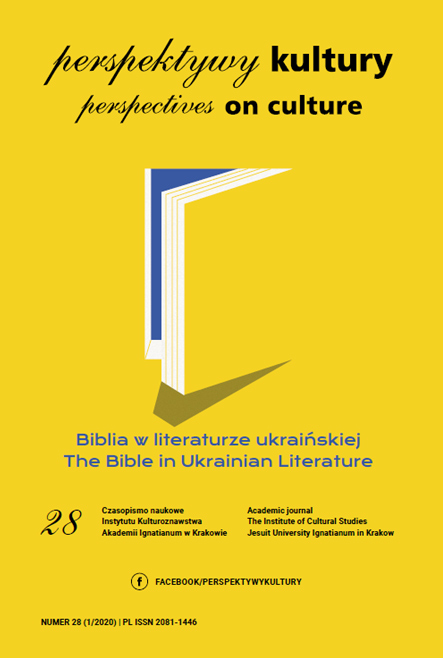Descriptions of Culture in the Media as a Search for its True Image
Abstract
The article confirms the thesis that culture is understood in various ways. There are people who do not know culture and those who want to know more about it. Such a desire stems from the need to solve the problem that arises from different understandings of culture and from the fact that what some people call culture, others call anti-culture. The fact that the media are used in the search for the true image of culture is presented in the article through an analysis of the messages presented in the media. If we assume that the role of the media is to help people to discover the truth by discussing issues that are relevant to people’s lives, we can say that they truly undertake such a task when it comes to culture. The media emphasize the fact that values such as truth, goodness, and beauty are present in culture. All of these values come from God and lead to him. They make mankind need and search for culture continuously. Thanks to them, we can experience holistic development and understand more deeply what the essence of true humanity is. Without these divine values, human life—marked by false anthropocentrism—will always be filled with activities that can be described as “anti-culture.”
On the basis of selected texts, the article demonstrates the dependence between recognizing true culture and accepting responsibility for it. This responsibility is expressed in a constant effort to broaden one’s horizons of thought, to engage in various areas of life, and to create—through true universal fraternity—various communities. This way, the proper development of not only culture, but also of humanity can take place. It is also the path which leads to an effective defense against secular humanism, which is so hostile to religion.
References
Białous, A. (2018, October 10). Olsztyn: profanacja krzyża i antypolska prowokacja w miejskiej galerii sztuki [Olsztyn: Desecration of the cross and anti-Polish provocation in the municipal art gallery]. PCh24.pl. https://www.pch24.pl/olsztyn--profanacja-krzyza-i-antypolska-prowokacja-w-miejskiej-galerii-sztuki,63377,i.html
Catholic Information Agency. (2013, November 13). Przemyska młodzież do ministra kultury: stop profanacji symboli religijnych [Przemyśl youth to the Minister of Culture: Stop the profanation of religious symbols]. https://www.pch24.pl/przemyska-mlodziez-do-ministra-kultury--stop-profanacji-symboli-religijnych,19148,i.html
Cyz, T. (2011, December). Kultura mówienia prawdy. Z Michałem Merczyńskim i Pawłem Potoroczynem rozmawia Tomasz Cyz [The culture of telling the truth: Tomasz Cyz interviews Michał Merczyński and Paweł Potoroczyn]. Dwutygodnik. https://www.dwutygodnik.com/artykul/3000-kultura-mowienia-prawdy.html
Dec, I. (2013, No. 11). Bóg ukryty w pięknie świata [God hidden in the beauty of the world]. https://www.niedziela.pl/artykul/104958/nd/Bog-ukryty-w-pieknie-swiata
Dec, I. (2019). Awersja do Boga w czasach nowożytnych [Aversion to God in modern times]. Niedziela, Edycja Świdnicka 42(2), p. 5.
Francis. (2019, June 9). Orędzie Franciszka na Nadzwyczajny Miesiąc Misyjny [Message of His Holiness Francis for World Mission Day 2019] (Catholic Information Agency/ad, Polish Trans.). https://stacja7.pl/zwatykanu/oredzie-franciszka-na-nadzwyczajny-miesiac-misyjny
Frischmann, B. (2006, December 20). Defining “culture”. http://madisonian.net/2006/12/20/defining-culture
Garcia, R. (n.d.) Co mówi Chrystus w “Golgota Picnic”? Przeczytaj, zanim rzucisz kamieniem. Tekst sztuki Rodriga Garcii [What does Christ say in Golgotha Picnic? Read before you cast a stone: Text of Rodrigo Garcia’s play]. Wyborcza. http://wyborcza.pl/magazyn/1,124059,16232855,Co_mowi_Chrystus_w__Golgota_Picnic___Przeczytaj__zanim.html
Horak, T. (2018, February 10). Kultura – biała plama [Culture – terra incognita]. https://kosciol.wiara.pl/doc/4499754.kultura-biala-plama
John Paul II. (1990, December 7). Encyclical “Redemptoris missio” On the permanent validity of the Church’s missionary mandate.
Jureczko-Wilk, J. (2016, July 20). Chrzcielnica, 2Tm2,3 i sękacz [Baptismal font 2Tm2,3 and traditional spit cake]. https://kosciol.wiara.pl/doc/3302410.Chrzcielnica-2Tm2-3-i-sekacz
Kampania Wolności Sztuki i Nauki. (2017). Apel o nieograniczanie wolności sztuki i prawa do korzystania z dóbr kultury! [An appeal not to limit the freedom of art and the right to access cultural heritage!]. https://naszademokracja.pl/petitions/apel-o-nieograniczanie-wolnosci-sztuki-i-prawa-do-obejrzenia-spektaklu-klatwa-w-teatrze-rozrywki
Kerner, A. (2014, June 12). Kultury moc [The power of culture]. https://www.gosc.pl/doc/2042734.Kultury-moc/2
Kołodziej, A. (2014, December 30). Uczestnictwo w kulturze [Participation in culture]. https://prasa.wiara.pl/doc/2300110.Uczestnictwo-w-kulturze
Kowalski, J. (2014). “Golgota Picnic”: Czego nam nie mówią o tym przedstawieniu [Golgotha Picnic: What they are not telling us about this performance]. http://christianitas.org/news/golgota-picnic-czego-nam-nie-mowia-o -tym-przedstawieniu
Meetschen, S. (2015). Antykultura [Anti-Culture]. Idziemy 8, p. 8.
O’Neil, D. (2006). What is culture? https://www2.palomar.edu/anthro/culture/culture_1.htm
Paul VI. (1975, December 8). Apostolic exhortation “Evangelii nuntiandi” On evangelization in the modern world.
Rosik, S. (1992). Wyzwania i wybory moralne. Refleksje teologicznomoralne [Moral challenges and choices: Theological and moral reflections]. Catholic University of Lublin Publishing House.
Sandbrook, D. (2016). The great British dream factory: The strange history of our national imagination. Allen Lane.
Second Vatican Council. (1965, December 7). The pastoral constitution Gaudium et spes On the Church in the modern world.
Sochoń, J. (2015, September 15). Świat wartości Jana Pawła II [John Paul II’s world of values]. http://idziemy.pl/kosciol/swiat-wartosci-jana-pawla-ii
Winiarczyk, M. (2019). Dla kogo pracuje Vega? [Who does Vega work for?]. Idziemy 37, p. 33.
Zielińska, S. (2017, July 31). Abp Skworc o „Klątwie”: apelujemy o odwołanie prowokacyjnego spektaklu [Archbishop Skworc on The Curse: We are calling for the cancellation of the provocative spectacle]. https://opoka.news/aktualnosci/6009
Copyright (c) 2020 Jesuit University Ignatianum in Krakow

This work is licensed under a Creative Commons Attribution-NoDerivatives 4.0 International License.
Autor, zgłaszając swój artykuł, wyraża zgodę na korzystanie przez Wydawnictwo Uniwersystet Ignatianum z utworu na następujących polach eksploatacji:
- utrwalania utworu w formie papierowej, a także na nośniku cyfrowym lub magnetycznym;
- zwielokrotnienia utworu dowolną techniką, bez ograniczenia ilości wydań i liczby egzemplarzy;
- rozpowszechniania utworu i jego zwielokrotnionych egzemplarzy na jakimkolwiek nośniku, w tym wprowadzenia do obrotu, sprzedaży, użyczenia, najmu;
- wprowadzenia utworu do pamięci komputera;
- rozpowszechniania utworu w sieciach informatycznych, w tym w sieci Internet;
- publicznego wykonania, wystawienia, wyświetlenia, odtworzenia oraz nadawania i reemitowania, a także publicznego udostępniania utworu w taki sposób, aby każdy mógł mieć do niego dostęp w miejscu i czasie przez siebie wybranym.
Wydawca zobowiązuje się szanować osobiste prawa autorskie do utworu.





